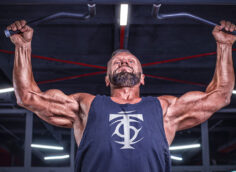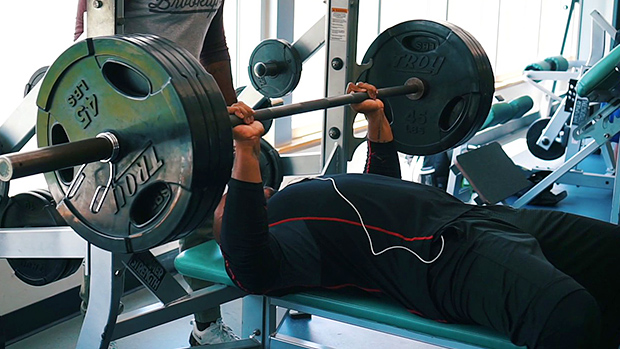If you're not having fun with your training, you won't stick to it for long. Add some basic arm balances for a playful element that'll improve your mobility, balance, strength, and body awareness. You'll feel like a kid again.
Try these after lifting or do them on your off days if you're looking for something that keeps you active yet won't wreck you physically.
1. Crow
- Begin in a catcher's squat position with your weight on your toes and your palms on the floor.
- Lift your knees and wrap them around your triceps, squeezing them tightly.
- Slowly shift your weight to your palms and lift your feet off the floor, keeping your eyes focused on one area of the floor in front of you. If you lose balance by lifting two feet, try lifting one at a time.
Be patient. You'll be surprised how fast the body catches on to this. The second or third time you try it, you'll nail it.
2. Side Crow
- Begin in a catcher's squat position with your knees close together.
- Twist your torso to the right and set your palms on the ground to the side of your legs.
- Using your left elbow as a scoop for your legs, shift your weight onto your palms, lifting your feet off the floor.
- If twisting to the right, your left elbow should be holding up your bottom thigh, and your right elbow should be tucked towards your ribcage.
- As an option, extend both knees and top hip.
3. Mountain Climber
- Begin in a modified runner's lunge with your right leg by your palms and your back knee bent.
- Shift your body to the left and place the inside of your right leg on your right elbow. Your left elbow should tuck into your ribcage.
- As you shift your weight onto your hands, extend your left hip so you reach your foot away from the body and up towards the ceiling.
- As a bonus, extend your right knee.
4. Peacock
- Begin in a kneeling position with a rounded upper back.
- Place your palms on the ground with your fingers pointing towards your feet.
- Lean forward, bend your elbows, and place your abdomen on top of your triceps.
- Rest your head on the ground as you extend your back legs.
- Lift your head and chest so that your body is parallel to the floor.
5. Wounded Peacock
- Begin in a kneeling position with your right hand down and your left arm to the side.
- Shift your body to the right and place your right elbow on your abdomen so that it's closer to the midline of your pelvis.
- Get your arm extended to the side with your palm on the ground.
- Lift your legs so that you're supporting your body weight on your right elbow.
- Slowly raise your left hand off the ground so that your only contact point to the ground is your right arm. Use a wide straddle stance if it helps with balance.
Hand Positioning on the Floor
It's important to find a hand position that feels comfortable yet gives you control. I recommend the cambered hand position:

Place your hand flat on the ground, then pull your fingers back toward your palm. Flex your fingers at the second knuckle or PIP joint (proximal interphalangeal joint). This will give you more points of contact with the floor and put the tendons in your hand into a stronger position.
Wrist Problems? Use Blocks
Arm balances can cause a lot of compression on the wrists. If you start having problems doing any of the exercises, just use a pair of hand-balancing blocks to help support your wrists. Hand-balancing blocks are much smaller than yoga blocks and will increase your control.
They come in different sizes, but here are the ones that work well:
- For most men: 4 inch wide x 5 inch long x 2-1/4 inch tall blocks
- For most women: 2-3/4 inch wide x 4-3/8 inch long x 2-1/4 inch tall blocks

You want your hand flat on the block with your thumb on one side, index and middle fingers at the top of the blocks, and your ring and pinky on the opposite side of your thumb. Your second knuckles should comfortably wrap around the block, and your thumb should be supported.





